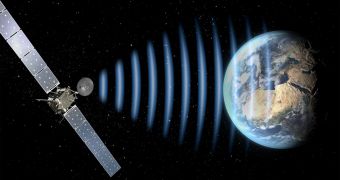Officials with the European Space Agency (ESA) are happy to announce that the Rosetta space probe, currently on its way to rendezvous with comet 67P/Churyumov-Gerasimenko later this year, successfully reestablished contact with Mission Control yesterday, January 21, 2014.
The first signals from the probe were received at 1818 GMT (19:18 CET), through the NASA Goldstone and Canberra ground stations. The spacecraft has been in hibernation mode since July 2011, to conserve energy ahead of its encounter with the comet.
After 31 months of inactivity, Rosetta was able to transmit data to Earth within the first window of opportunity ESA mission controllers scheduled for the vehicle. The probe was launched back in 2004, and flew around the Sun a total of five times.
Though currently flying some 800 million kilometers (500 million kilometers) away from the Sun, the vehicle is still 9 million kilometers (5.6 million miles) away from its rendezvous point. Rosetta is scheduled to enter orbit around comet 67P/Churyumov-Gerasimenko in May 2014.
“We have our comet-chaser back. With Rosetta, we will take comet exploration to a new level,” commented Alvaro Giménez, who is the Director of Science and Robotic Exploration at ESA.
“This incredible mission continues our history of ‘firsts’ at comets, building on the technological and scientific achievements of our first deep space mission Giotto, which returned the first close-up images of a comet nucleus as it flew past Halley in 1986,” he went on to say.
“This was one alarm clock not to hit snooze on, and after a tense day we are absolutely delighted to have our spacecraft awake and back online,” added the Rosetta mission manager at ESA, Fred Jansen.
Flying on a path that would enable it to meet 67P/Churyumov-Gerasimenko was not easy for Rosetta. The spacecraft had to perform three flybys of Earth and one close pass of Mars in order to acquire the right speed and trajectory for a safe arrival at its destination.
In addition to photographing and mapping the comet from orbit, the probe will also deploy the Philae lander, which will use its suite of 10 scientific instruments to conduct the most extensive series of analyses ever done on the surface of a comet.
“All other comet missions have been flybys, capturing fleeting moments in the life of these icy treasure chests. With Rosetta, we will track the evolution of a comet on a daily basis and for over a year, giving us a unique insight into a comet’s behavior and ultimately helping us to decipher their role in the formation of the Solar System,” says Rosetta project scientist, Matt Taylor.

 14 DAY TRIAL //
14 DAY TRIAL //